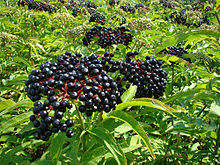Sambucus ebulus
| European dwarf elder | |
|---|---|

| |
| Danewort inflorescence | |
| Scientific classification | |
| Kingdom: | Plantae |
| Clade: | Tracheophytes |
| Clade: | Angiosperms |
| Clade: | Eudicots |
| Clade: | Asterids |
| Order: | Dipsacales |
| Family: | Adoxaceae |
| Genus: | Sambucus |
| Species: | S. ebulus
|
| Binomial name | |
| Sambucus ebulus | |
| Synonyms[1] | |
| |

Sambucus ebulus, also known as danewort, dane weed, danesblood, dwarf elder or European dwarf elder, walewort,
Description
Sambucus ebulus grows to a height of 1–2 m and has erect, usually unbranched stems growing in large groups from an extensive perennial underground stem rhizome. The leaves are opposite, pinnate, 15–30 cm long, with 5-9 leaflets with a foetid smell. The stems terminate in a corymb 10–15 cm diameter with numerous white (occasionally pink) flat-topped hermaphrodite flowers. The fruit is a small glossy black berry 5–6 mm diameter. The ripe fruit give out a purple juice.[2][6]
The name danewort comes from the belief that it only grows on the sites of battles that involved the
Toxicity
All parts of the plant are toxic, especially the seeds.[7][8]
Uses
Dwarf elder (Sambucus ebulus L) is one of the best known medicinal herbs since ancient times. In view of its benefits as a widely applicable phytomedicine, it is still used in folk medicine of different parts of the world. In addition to its nutritional values, dwarf elder contains different phytochemicals among which flavonoids and lectins are responsible for most of its therapeutic effects. Dwarf elder has been used for different ailments including: joint pains, cold, wounds, and infections."[7][9]
References
- ^ The Plant List
- ^ ISBN 0-246-11789-3. p. 103
- ^ USDA, NRCS (n.d.). "Sambucus ebulus". The PLANTS Database (plants.usda.gov). Greensboro, North Carolina: National Plant Data Team. Retrieved 28 October 2015.
- ^ "Elder (Dwarf) / Dwarf Elder / Danewort - Wild Flower Finder".
- ^ BONAP (Biota of North America Project) floristic synthesis, Sambucus ebulus
- ISBN 0 521 04656 4[page needed]
- ^ PMID 28397551.
- ^
Roth, Lutz; Daunderer, Max; Kormann, Kurt (2001). Giftpflanzen – Pflanzengifte. Giftpflanzen von A–Z. Notfallhilfe. Vorkommen. Wirkung. Therapie. Allergische und phototoxische Reaktionen (in German). Hamburg: Nikol. ISBN 3-933203-31-7.
- PMID 23770053.
External links
 Data related to Sambucus ebulus at Wikispecies
Data related to Sambucus ebulus at Wikispecies- Grieve, 'A Modern Herbal' (1931)
- "Sambucus ebulus". Plants for a Future.
- Sambucus ebulus in the CalPhotos photo database, University of California, Berkeley
